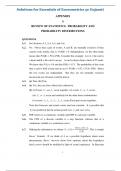Prüfung
Solutions for Essentials of Econometrics, 5th Edition by Damodar N. Gujarati
- Kurs
- Hochschule
Complete Solutions Manual for Essentials of Econometrics 5e 5th Edition by Damodar N. Gujarati. Full Chapters Solutions are included. Chapter 1 to 12 - Appendixes Solutions are included. Chapter 1. The Nature and Scope of Econometrics 1.1 What Is Econometrics? 1.2 Why Study Econometrics? ...
[ Mehr anzeigen ]



